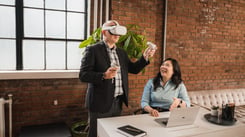As VR becomes more commonplace in the architecture and design industry it’s important to understand how to present to clients when using the technology. Often when presenting to clients it could be their first time experiencing the technology and you want to make sure you have the skills for a strong VR presentation for architecture in this still somewhat new medium.
In this post, we'll unveil our top 5 tips for VR presentations for architecture and how you can take advantage of a revolutionary tool that's transforming the way we communicate, collaborate, and captivate our audiences. Whether you're a seasoned VR pro or just beginning to explore its potential, these tips will help you harness the power of VR to create unforgettable VR presentations for architecture. Join us as we dive into the art of immersive storytelling and discover how to elevate your presentations to new heights.
VR Presentations for Architecture Tip 1 – Practice, Practice, Practice
Practice is the main tool for any successful presenter, and it holds even more weight in the realm of VR. Preparing for a presentation using VR demands more than just knowing your content; it immersive environment. VR presents a dynamic platform, where body language, spatial awareness, and audience engagement take on entirely new dimensions. As well, you need to have a firm grasp on the tech and software you are using. You need to make sure you know how to navigate easily through your VR environment so you can the presentation feel as smooth as possible for a new VR user.
Practicing within the VR environment is essential to navigate this transformation effectively. The more you practice in VR, the more you'll become attuned to its unique dynamics, enabling you to present with confidence and finesse. In the world of immersive storytelling, practice is the key to unlocking the full potential of VR presentations.
Finally, make sure the ‘start’ scene of your project is an appealing one - you don’t want the first impression from your client to have them facing a corner and unsure of where to look, so practice the ‘first moments’ your client will be in the headset, too.
VR Presentations for Architecture Tip 2 – Be a Guide, but Let Them Explore
You will need to find the right balance of how guided your VR presentation should be. The key draw of any VR experience is the immersion and the ability to look where you want and see things that you are interested in. While the goal of your presentation is to highlight the work and decisions you made and you want to make sure they are aware, you should balance that with your audience by allowing them to explore on their own for a part of the presentation.
When it comes to the point in the presentation where you want to be a little more direct, you can use the tools that Yulio has such as spotlight and markup tools to draw viewer attention and highlight key parts of your project. You can easily get everyone on the same page and look at what you want them to see. We suggest building in a little time when clients first put the headset on to let them look around and get acclimatized and then begin you guided tour. The benefit of using a tool like Yulio is that you can always see exactly what your client is looking at, so you’ll be better able to jump in at the right times.
VR Presentations for Architecture Tip 3 – Consider Engagement Opportunities
We find that allowing your audience to explore as suggested in the last tip, gets them more engaged as they examine the different parts of your VR project. They can make small discoveries for themselves of “Oh that looks interesting” and “Oh I love this setup” but it can also bring questions up such as “Should this go here?” and “Are there other options for this?”. Follow along with your audience as they explore and be ready to answer these questions. Yulio allows you to follow a viewer’s perspective so it will be easy for you to see what they are asking about and have clarity.
Instead of waiting for these opportunities to come organically, beforehand, think of some opportunities or questions that you can bring up during the presentation to encourage some engagement. If you’re using Yulio, you can take advantage of our VR hotspots. Plant some text, images, or even AR objects to get your viewers engaged with your presentation.
VR Presentations for Architecture Tip 4 – Keep Renders Clean and Appealing
One thing you can do to make your VR presentations easier to follow is to make your renders clean and minimalistic in some of the décor. If you have an extremely busy render full of intricate details and embellishments, it can overwhelm your viewer. While it may look lovely and make your render more “pretty”, it can distract from the key aspects. When creating your render with whatever tool you’re using, look at what are the essential aspects of your design and make sure to highlight those so that any extras don’t get in the way.
Some of our clients also find success with presenting lower fidelity renderings, keeping things grayscale or only focused on something like scale rather than full design - it helps keep your presentations focused on the areas where you most want decisions, rather than getting caught up in comments about color and finishes.
VR Presentations for Architecture Tip 5 – Tailor your Presentations for Your Audiences
Our final recommendation is to do a little research on who you are presenting to, especially regarding their familiarity with VR. If you know that they haven’t used VR before, make sure you set up your presentation to ease them into the process. But also, you should make sure that your viewers don’t suffer from something like motion sickness or claustrophobia, as wearing a VR headset can exacerbate those conditions and make the whole experience a whole lot less pleasurable. If your audience isn’t open to VR consider other options. At Yulio, we still let you explore your space on a desktop screen without the full VR element. Or consider adding more AR options so that you can still have an immersive tech moment with your audience.
Typically, our clients find that presenting with the intention of popping in and out of the experience allows conversation and makes people less concerned about nausea or frankly, feeling foolish if they can’t see what’s around them. So, explain in advance that they don’t have to worry about controlling the scene and should feel free to pop out at their preference.
Start Enhancing Your Architecture Presentations with VR
We hope that you find these tips helpful when you are presenting with VR. We can’t wait to see the inventive ways you use VR at your firms and practices and hear client stories who fall in love with VR.
If you’re looking for more tips and tricks with VR, you can check out our guide to incorporating it into your workplace along with some key considerations. If you're curious as to what headset we recommend, you can check out our headset recommendations.







